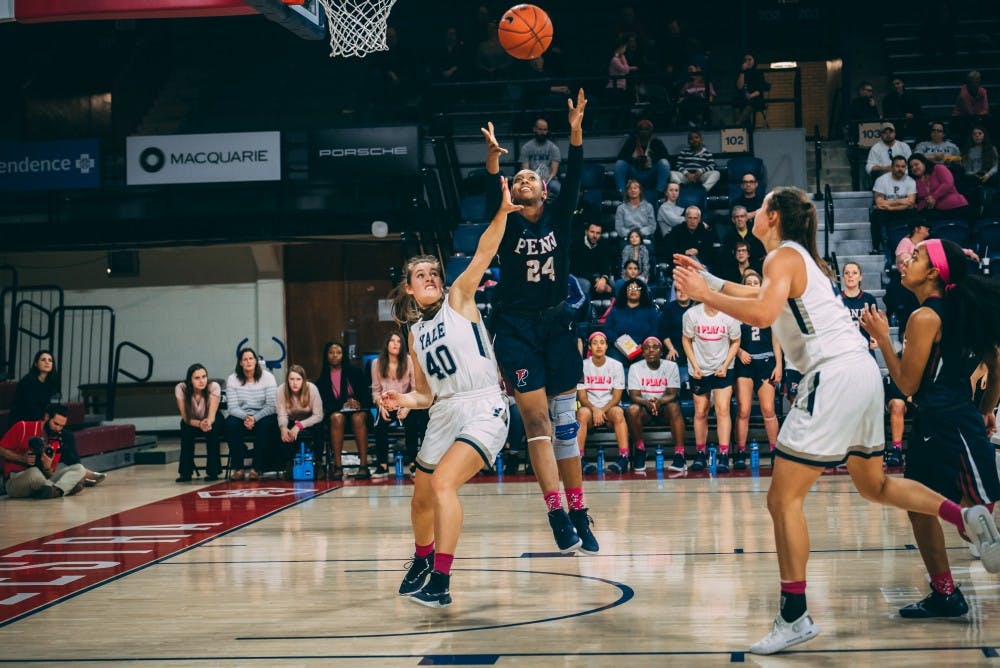
Despite Yale's tough defense, sophomore forward Tori Crawford and the Quakers managed to remain undefeated in the Ivy League.
Credit: Christian WaltonWith the help of a double-digit halftime lead, Penn women’s basketball was able to hang on to defeat a visiting Yale team, 54-48, on the second night of a back-to-back. It was certainly a little too close for comfort, but the Quakers showed their winning, even-keeled character while withstanding the Bulldogs’ second-half rally. Here’s what we learned from the Red and Blue’s victory.
That stingy defense shows up against tough competition, too
The more single-digit quarters that Penn can get from its opponents, the better, right? Just a night after limiting a sliding Brown team to just six second-quarter points along the way to a resounding victory, the Quakers held a Yale team riding a four-game winning streak to just seven points in the opening ten minutes of play on Saturday night.
That kind of result starts with active defenders blocking lanes and deflecting passes. The Red and Blue forced seven turnovers in the first quarter and capitalized on the other end by scoring six points off those turnovers.
“Both teams didn’t get a whole lot of run-outs in transition, a lot of the game was played in the half court,” coach Mike McLaughlin said. “Both teams are very good defensively, so we both had to grind it in the half court a little bit.”
Nobody for the Bulldogs was getting clean looks at the basket, especially around Eleah Parker. The sophomore center had two first-quarter blocks and finished with five rejections for the game to accompany her 16-point, 12-rebound double-double. Penn knew that it would have to contain Yale’s junior guard Roxy Barahman, who entered the game leading the Ivy League in scoring at 19.3 points per game. The Quakers did just that, holding Barahman to 14 points.
This group is tough as nails
It’s nothing new to see senior guard Ashley Russell diving on the court or Parker battling inside for rebounds, but this game got especially physical when Yale started cutting into the Red and Blue’s lead in the third and fourth quarters.
While hustle plays don’t show up in the box score, the Quakers were hitting the floor and bumping bodies all night long. The refs let both teams play as the game wore on, but Penn turned loose balls into jump balls and rebounded through contact. Even when the whistles did blow – sophomore forward Tori Crawford took a particularly hard foul under the basket and junior guard Kendall Grasela ran into multiple tough, illegal screens – the Red and Blue got up and kept fighting every time.
They know how to find different ways to win
Playing with a lead is hard, and the competitiveness of Ivy League games doesn’t make things any easier. This game was very much a tale of two halves; after a strong offensive showing in the first half coupled with customarily impenetrable defense, the Quakers went cold in the second half.
When the Bulldogs started to make shots and work their way back into the game, though, Penn did nothing to beat itself.
“I don’t think we turned the ball over — you know, we only had seven turnovers,” McLaughlin said. “When you don’t give up the ball, [the other team doesn’t] get a chance to run out, which [Yale does] well.”
Parker scored 12 points in the first quarter, but she took until the fourth quarter to score again because of her foul trouble. Despite their struggles in their half-court offense without Parker on the floor – Penn shot 31 percent from the field, including 28 percent from beyond the arc – the Quakers used their scrappy playing style to manufacture points with 10 steals and 18 offensive rebounds.
Just one night after scoring 80 points and winning by 40, the Red and Blue barely crossed the 50-point mark and won by six.
“Regardless of what happens the night before — and we talk about this — it’s a fresh start the next day,” McLaughlin said. “They’re tired, we’re tired, and you’ve just got to find a way to get it done.”
That sort of versatility, combined with mental and physical toughness, will keep winning games and bodes well for the remainder of the ever-demanding Ivy League schedule.
The Daily Pennsylvanian is an independent, student-run newspaper. Please consider making a donation to support the coverage that shapes the University. Your generosity ensures a future of strong journalism at Penn.
Donate







